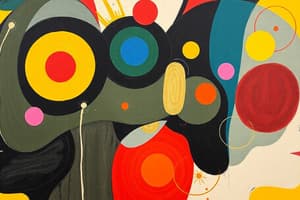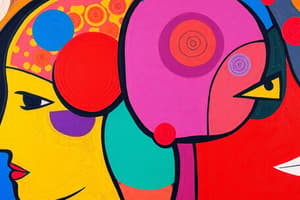Podcast
Questions and Answers
¿Cuál de las siguientes opciones describe mejor la agnosia?
¿Cuál de las siguientes opciones describe mejor la agnosia?
- Dificultad para mantener la atención.
- Pérdida de la memoria a corto plazo.
- Alteración en la percepción del tiempo.
- Incapacidad para procesar información sensorial. (correct)
La anosognosia implica la percepción de una parte del cuerpo como ajena o extraña.
La anosognosia implica la percepción de una parte del cuerpo como ajena o extraña.
False (B)
¿Qué tipo de agnosia se caracteriza por la incapacidad de reconocer objetos mediante el tacto?
¿Qué tipo de agnosia se caracteriza por la incapacidad de reconocer objetos mediante el tacto?
Asterognosia
La prosopagnosia se manifiesta como la dificultad para reconocer rostros ______.
La prosopagnosia se manifiesta como la dificultad para reconocer rostros ______.
Empareja los siguientes trastornos con su descripción:
Empareja los siguientes trastornos con su descripción:
¿Cuál de los siguientes trastornos se relaciona con una alteración en la percepción del yo físico, donde una persona puede sentir que su cuerpo le es ajeno?
¿Cuál de los siguientes trastornos se relaciona con una alteración en la percepción del yo físico, donde una persona puede sentir que su cuerpo le es ajeno?
El miembro fantasma es un ejemplo de anosognosia.
El miembro fantasma es un ejemplo de anosognosia.
¿Cómo se denomina la sensación de extrañeza hacia el mundo exterior?
¿Cómo se denomina la sensación de extrañeza hacia el mundo exterior?
La despersonalización se describe como sentirse ______ o diferente de uno mismo.
La despersonalización se describe como sentirse ______ o diferente de uno mismo.
Relacione los siguientes trastornos del yo corporal con su descripción:
Relacione los siguientes trastornos del yo corporal con su descripción:
¿Cuál de los siguientes es un trastorno del yo psíquico relacionado con una concepción errónea de quién es uno mismo?
¿Cuál de los siguientes es un trastorno del yo psíquico relacionado con una concepción errónea de quién es uno mismo?
Un trastorno del gobierno del 'yo' se caracteriza por la sensación de control total sobre las propias acciones y pensamientos.
Un trastorno del gobierno del 'yo' se caracteriza por la sensación de control total sobre las propias acciones y pensamientos.
¿Qué tipo de trastorno mental se asocia con ideas delirantes y alucinaciones?
¿Qué tipo de trastorno mental se asocia con ideas delirantes y alucinaciones?
La ______ es un trastorno de ansiedad caracterizado por una preocupación excesiva y persistente.
La ______ es un trastorno de ansiedad caracterizado por una preocupación excesiva y persistente.
Empareja los siguientes trastornos mentales con su descripción:
Empareja los siguientes trastornos mentales con su descripción:
¿Cuál de los siguientes síntomas NO es característico de la fase activa de la esquizofrenia?
¿Cuál de los siguientes síntomas NO es característico de la fase activa de la esquizofrenia?
Un paciente en estado catatónico presenta alta conciencia y capacidad de responder a estímulos.
Un paciente en estado catatónico presenta alta conciencia y capacidad de responder a estímulos.
¿Qué tipo de fármacos se utilizan comúnmente en el tratamiento de la manía bipolar?
¿Qué tipo de fármacos se utilizan comúnmente en el tratamiento de la manía bipolar?
El delirio de ______ se caracteriza por la creencia de que se ha cometido un acto terrible
El delirio de ______ se caracteriza por la creencia de que se ha cometido un acto terrible
Asocie cada fase del sueño con su característica principal:
Asocie cada fase del sueño con su característica principal:
¿Cuál de las siguientes hormonas NO está directamente relacionada con la regulación del sueño?
¿Cuál de las siguientes hormonas NO está directamente relacionada con la regulación del sueño?
La luz artificial no influye en el ritmo circadiano del sueño.
La luz artificial no influye en el ritmo circadiano del sueño.
¿Cómo se llama al trastorno del sueño caracterizado por pesadillas frecuentes durante la fase REM?
¿Cómo se llama al trastorno del sueño caracterizado por pesadillas frecuentes durante la fase REM?
La disomnia se caracteriza por alteraciones en la cantidad o ______ del sueño.
La disomnia se caracteriza por alteraciones en la cantidad o ______ del sueño.
Relacione cada tipo de insomnio con su descripción:
Relacione cada tipo de insomnio con su descripción:
Flashcards
¿Qué es Agnosia?
¿Qué es Agnosia?
Incapacidad para procesar información sensorial.
¿Qué es Anosognosia?
¿Qué es Anosognosia?
Inconsciencia o negación de una enfermedad o discapacidad.
¿Qué es Asomatognosia?
¿Qué es Asomatognosia?
Incapacidad de reconocer o ser consciente de las partes del propio cuerpo.
¿Qué es Asterognosia?
¿Qué es Asterognosia?
Signup and view all the flashcards
¿Qué es Prosopagnosia?
¿Qué es Prosopagnosia?
Signup and view all the flashcards
¿Qué es Agnosia Digital?
¿Qué es Agnosia Digital?
Signup and view all the flashcards
¿Qué es Despersonalización?
¿Qué es Despersonalización?
Signup and view all the flashcards
¿Qué es Desrealización?
¿Qué es Desrealización?
Signup and view all the flashcards
¿Qué es un Delirio?
¿Qué es un Delirio?
Signup and view all the flashcards
¿Qué es la Manía?
¿Qué es la Manía?
Signup and view all the flashcards
¿Qué es la Depresión?
¿Qué es la Depresión?
Signup and view all the flashcards
¿Qué es Hipocondría?
¿Qué es Hipocondría?
Signup and view all the flashcards
¿Qué es la Dismorfobia?
¿Qué es la Dismorfobia?
Signup and view all the flashcards
¿Qué es Psicosis?
¿Qué es Psicosis?
Signup and view all the flashcards
¿Qué es Esquizofrenia?
¿Qué es Esquizofrenia?
Signup and view all the flashcards
¿Qué son los Delirios?
¿Qué son los Delirios?
Signup and view all the flashcards
¿Qué es Pensamiento Desorganizado?
¿Qué es Pensamiento Desorganizado?
Signup and view all the flashcards
¿Qué son Alucinaciones?
¿Qué son Alucinaciones?
Signup and view all the flashcards
¿Qué es el Ritmo Circadiano?
¿Qué es el Ritmo Circadiano?
Signup and view all the flashcards
¿Qué es el Insomnio?
¿Qué es el Insomnio?
Signup and view all the flashcards
¿Qué son las Parasomnias?
¿Qué son las Parasomnias?
Signup and view all the flashcards
¿Qué es la Hipersomnia?
¿Qué es la Hipersomnia?
Signup and view all the flashcards
¿Qué son Mioclonías Nocturnas?
¿Qué son Mioclonías Nocturnas?
Signup and view all the flashcards
¿Qué es el Síndrome de las Piernas Inquietas?
¿Qué es el Síndrome de las Piernas Inquietas?
Signup and view all the flashcards
Study Notes
- These notes discuss various topics related to processes of sensory information, disorders of the body and self, mental disorders, sleep disorders, and schizophrenia.
Sensory Information and Related Disorders
- Nosia refers to sensory information processing.
- Agnosia is the failure to process sensory information.
- Asomatognosia is the lack of recognition of one's own body.
- Asterognosia is the inability to recognize objects through touch.
- Prosopagnosia is the inability to recognize familiar faces.
- Agnosia digital is the inability to recognize one's own hand.
- Anosognosia is a lack of awareness of one's own disease.
Disorders of the Self
- Disorders of the bodily self include anosognosia, phantom limb syndrome, and asomatognosia
- Disorders of the psychic self are characterized with having an erroneous concept of who you are.
- Disorders of the governance of the self involve a sensation of being incapable of directing one's actions and thoughts.
- Depersonalization is when one feels different or changed.
- Derealization is when there is a sense of strangeness towards the external world
Mental Disorders
- Anxiety disorders include anxiety and anguish.
- Psychotic disorders include schizophrenia, delusions, and hallucinations.
- Affective disorders include mania and bipolar disorder.
- Somatoform disorders include hysteria.
- Obsessive-compulsive disorder (OCD) involves obsessions (ideas) and compulsions (rituals).
- Phobias are characterized by fear.
- Hypochondria is having concerns about diseases and illnesses.
- Dysmorphophobia is characterized by obsession about perceived defects with their own body.
- Somatoform disorders can manifest as conversion disorders from hysteria.
Schizophrenia
- Schizophrenia is a mental disorder characterized by distortions in reality.
- Positive symptoms of Schizophrenia: Delusions, hallucinations and thought disorders.
- Negative symptoms of Schizophrenia: Emotional dulling, poverty of speech, decline in motivation.
- Disorganized Symptoms of Schizophrenia: Disorganized or nonsensical speech or behavior.
- Prodromal phase: Symptoms before the full manifestation of the illness.
- Active phase: Presence of psychotic symptoms like hallucinations and delusions.
- Residual phase: symptoms no longer prominent.
Mood Disorders
- Mania: Includes elevated mood, racing thoughts.
- Hypomania: a milder form of mania.
- Bipolar Disorder: Cycles between mania and depression.
- Depression: Characterized by intense sadness.
- Delirium: The person may have false beliefs in relation to negation of the world.
- Cotard Syndrome: A kind of delusion involving negation.
- Ruin: Future full of unhappiness and fatalities.
- Guilt: The person might think and feel they’ve done a horrible action and take the blame.
- Catastrophe: believing the end of the world and destiny for destruction.
- Hypochondriac: Believing that you have an illness when you are healthy.
Consciousness Disorders
- Quantitative: alterations of consciousness
- Obnubilation: Clouding of consciousness.
- Somnolence: Excessive sleepiness or drowsiness.
- Sopor: State of reduced awareness or responsiveness.
- Coma: A deep state of prolonged unconsciousness.
- Qualitative: alterations of consciousness
- Delirium: A state of acute confused state.
- Twilight state: Altered state of consciousness.
- Stupor: State of unresponsiveness.
- Consciousness of the self - can be divided into:
- Bodily self: This includes one’s identification with their own body
- Psychic self: Including one’s self-perception and individual memories
- Unity between self and world: The subjective relationship between oneself and the outside world
Sleep Disorders
- Circadian rhythm is nictemeral (day/night), and light marks the rhythm.
- The hypothalamus is the "clock."
- Substances that are cofactors of sleep: serotonin, acetylcholine, and GABA.
- Substances that maintain wakefulness: adrenaline, noradrenaline, dopamine, and catecholamines.
- Hormones involved in sleep: cortisol, prolactin, melatonin, and growth hormone.
Sleep Stages
- Non-REM (NREM) sleep allows the body to recover:
- Stage 1: Light sleep, few minutes, somnolence and relaxation, but not fully asleep.
- Stage 2: Light sleep, fully asleep, can be awakened easily.
- Stage 3: Deep sleep, difficult to wake up, confusion and disorientation.
- Stage 4. Very deep sleep, hard to despert, can suffer sleepwalking, and night terrors.
- REM (Rapid Eye Movement) sleep helps the psychic part recover:
- Dreams occur, with increased cerebral activity, rapid eye movements, and increased heart rate.
- Consolidates learning and memory. Lack of sleep contributes to dementia.
- The sleep cycle lasts 70-80 minutes.
- Stage 1: 5%
- Stage 2: 25%
- Stages 3 and 4: 45%
- REM: 25%
- In elderly people, sleep fragmentation occurs, with decreased time in deep sleep (Stage IV).
Duration of Sleep
- Duration of sleep includes sleep efficiency, time spent in bed asleep, sleep latency, and wake-ups.
Sleep disorders include dyssomnias and parasomnias.
- Dyssomnia, quantity and quality issues.
- Parasomnias are like nightmares during REM sleep.
- Insomnia: present at least 3 times per week for one month.
- Can affect concentration, irritability, and mood.
- Widespread in the elderly.Types of insomnia are classified by the moment of appearance and duration: conciliation or maintenance.
- Conciliation insomnia- Difficult to fall asleep.
- Maintenance insomnia- Waking up during the night and it takes some time or cannot fall asleep. -Transient: lasting less than 1 week.
- Short Duration: lasting up to 3 weeks.
- Chronic: Occurring for more than a month.
- Insomnia treatment includes hypnotics (benzodiazepines).
- Hyperinsomnia: Extended duration of sleep.
- Myoclonias: Sudden, involuntary muscle jerks
- Restless Legs Syndrome: Periodic sensations in the legs.
- Sleep medications affect a patient's memory, alertness, cognition.
Studying That Suits You
Use AI to generate personalized quizzes and flashcards to suit your learning preferences.


